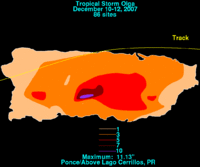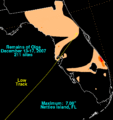Tropical Storm Olga (2007) facts for kids
| Tropical storm (SSHWS/NWS) | |

Subtropical Storm Olga on December 11.
|
|
| Formed | December 11, 2007 |
|---|---|
| Dissipated | December 13, 2007 |
| Highest winds | 1-minute sustained: 60 mph (95 km/h) |
| Lowest pressure | 1003 mbar (hPa); 29.62 inHg |
| Areas affected | Puerto Rico, Hispaniola |
| Part of the 2007 Atlantic hurricane season | |
Tropical Storm Olga was the 15th named storm during the 2007 Atlantic hurricane season. It formed in the second week of December, even after the official hurricane season had ended. This made it a "post-season" storm, which is quite rare!
Olga started as a low-pressure area east of the northern Lesser Antilles. It slowly became a subtropical storm. On December 10, the NHC officially named it Subtropical Storm Olga when it was just north of Puerto Rico.
The storm then moved towards the Dominican Republic. It made landfall there on December 11. After hitting land, Olga changed into a tropical storm. It moved across Hispaniola (the island shared by the Dominican Republic and Haiti) and then entered the Caribbean Sea. However, conditions were not good for the storm, and Olga quickly weakened. It became just a leftover low-pressure area by December 13.
Olga affected many places that had already been hit by Tropical Storm Noel a month earlier. In Puerto Rico, heavy rain caused one death. In the Dominican Republic, 37 people died. This included 20 deaths from water released from a dam in Santiago Province. Haiti also reported two deaths.
Contents
How Tropical Storm Olga Formed and Moved
In early December, a low-pressure system moved west. This created a wide area of low pressure, called a trough, east of the northern Lesser Antilles. This trough slowly moved westward. It caused scattered thunderstorms and some turning of the air.
By December 8, the thunderstorms became more organized. Forecasters started to think a tropical storm might form. The system moved west over warm ocean waters. On December 10, a center of circulation began to form. Even though the thunderstorms were spread out, they started to get closer to the center.
On December 11, the National Hurricane Center officially called it Subtropical Storm Olga. It was about 55 miles (85 km) east of San Juan, Puerto Rico.
After becoming a subtropical storm, Olga continued to move west-southwest. It strengthened a little as it moved along the northern coast of Puerto Rico. Olga then made landfall near Punta Cana, Dominican Republic, on December 11.
A special plane called the Hurricane Hunters flew into the storm. They reported that Olga had winds of 60 mph (95 km/h). On December 12, the National Hurricane Center changed Olga's classification to a tropical cyclone. This happened while it was still over land.
As Olga crossed central Hispaniola, its thunderstorms quickly weakened. When it reached the Caribbean Sea, it no longer had enough strong thunderstorms to be a tropical cyclone. The center of the storm became very disorganized. By late December 12, Olga weakened to a tropical depression. The National Hurricane Center stopped giving updates on Olga early on December 13. At that time, it was about 80 miles (130 km) northwest of Kingston, Jamaica.
Getting Ready for the Storm
On December 10, the Tropical Prediction Center warned about strong winds north of the Lesser Antilles, Puerto Rico, and the Dominican Republic. This was because of the weather system that would soon become Olga.
As soon as Olga was named a subtropical cyclone, the government of the Dominican Republic issued a tropical storm warning. This warning covered the north coast from Cabo Engaño to the border with Haiti. A tropical storm watch was also put in place for the southern coast near Santo Domingo.
Because the strongest winds were far from its center, Puerto Rico did not get a tropical storm warning. Just before the storm hit, Haiti issued a tropical storm warning for its northern coast. Later, the Turks and Caicos Islands and the southeastern Bahamas also received tropical storm warnings.
The National Weather Service office in San Juan issued a flood watch for all of Puerto Rico. This included the islands of Culebra and Vieques. Heavy rainfall also led to flash flood warnings in many areas. Ferry services between Fajardo and the islands of Culebra and Vieques were stopped.
In the Dominican Republic, officials opened shelters in 15 provinces. People in low-lying areas were told to leave their homes for safety. Citizens in 22 communities were evacuated.
How Tropical Storm Olga Affected People

Tropical Storm Olga brought light to moderate precipitation (rain) to Puerto Rico. The most rain fell in Villalba, with 9.54 inches (242 mm). The rain caused several rivers to rise above their normal levels. For example, the Arecibo Big River was several feet above flood stage.
The storm left about 79,000 people without electricity and 144,000 people without water. In the northern part of Puerto Rico, the rain caused a mudslide. It buried a car, and the driver sadly died.
Very heavy rain fell across the Dominican Republic. Some areas were expected to get up to 10 inches (250 mm) of rain. The rain caused flooding along the River Yaque del Norte. There was a worry that the Tavera Dam on the river might break. This could have killed thousands of people in Santiago Province.
Instead, officials decided to open all six floodgates at the dam. This happened at 4:00 AM UTC on December 12. They released about 1.6 million gallons (6.1 million liters) of water into the river every second. This created a 66 foot (20 m) wave of water. Many people were caught off guard because it was late at night and they had only about 15 minutes to prepare. This decision led to at least 20 deaths. Homes in seven towns were flooded.
Two other deaths were reported in other parts of the country. More than 34,000 people had to leave their homes because of the storm. Over 7,500 houses were damaged. In nearby Haiti, two deaths were reported in the northern part of the country.
On December 11, a weather station in the Turks and Caicos Islands recorded steady winds of 36 mph (58 km/h).
More Information
- NHC's advisory archive on Tropical Storm Olga.
|
Tropical cyclones of the 2007 Atlantic hurricane season |
|||||||||||||||||||||||||||||||||
|
|
||||||||||||||||||||||||||||||||
|
|
|||||||||||||||||||||||||||||||||
Images for kids



